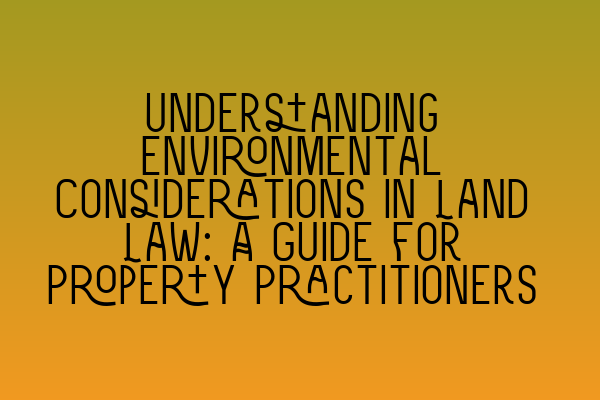Understanding Environmental Considerations in Land Law: A Guide for Property Practitioners
Introduction:
As property practitioners, it is essential to have a comprehensive understanding of the various factors that can impact land transactions. One crucial aspect that often requires careful consideration is the environment. This guide aims to provide property professionals with insights into the key environmental considerations in land law, enabling them to navigate these complexities effectively.
1. Assessing Environmental Risks:
When dealing with land transactions, it is crucial to assess the potential environmental risks associated with the property. This includes identifying any contamination issues, such as soil, water, or air pollution, which can have serious legal implications. Understanding the various types of contamination and their potential impact is essential for ensuring a smooth transaction process.
2. Regulatory Compliance:
Compliance with environmental regulations is a fundamental responsibility for property practitioners. Familiarize yourself with the relevant legislation, such as the Environmental Protection Act 1990, the Wildlife and Countryside Act 1981, and the Town and Country Planning Act 1990. Staying up to date with the changes in environmental laws will help you ensure that your clients are meeting their legal obligations.
3. Environmental Impact Assessments:
In certain cases, particularly for large-scale development projects, an Environmental Impact Assessment (EIA) may be required. This assessment examines the potential environmental effects of a proposed project, including its impact on the local ecosystem, air and water quality, and cultural heritage. Understanding the process and requirements of an EIA will be essential when advising clients involved in such projects.
4. Protected Areas and Conservation Designations:
Certain areas are protected by law due to their ecological, historical, or cultural significance. These include Sites of Special Scientific Interest (SSSIs), National Parks, and Areas of Outstanding Natural Beauty (AONBs). When dealing with properties located within or adjacent to these areas, it is important to understand the implications and limitations imposed by these designations.
5. Flooding and Water Management:
Flooding is a significant concern in land transactions, particularly in areas prone to heavy rains or coastal erosion. Understanding the potential flood risks and having knowledge of flood mitigation measures is crucial. Additionally, familiarize yourself with the Water Resources Act 1991 and the Flood and Water Management Act 2010 to ensure compliance and protect your clients’ interests.
Conclusion:
Environmental considerations play a pivotal role in property transactions, and property practitioners must be well-versed in this aspect of land law. By understanding potential environmental risks, complying with regulatory requirements, and considering the impact on protected areas, floods, and water management, property professionals can help their clients navigate any potential issues that may arise during land transactions.
At SQE Property Law & Land Law, we understand the importance of environmental considerations in land law. Our team of experienced solicitors is well-equipped to provide expert advice and assistance in navigating these complexities. Contact us today to ensure a smooth and compliant land transaction for your clients.
Related Articles:
– SQE 1 Practice Exam Questions
– SQE 1 Practice Mocks FLK1 FLK2
– SQE 2 Preparation Courses
– SQE 1 Preparation Courses
– SRA SQE Exam Dates
